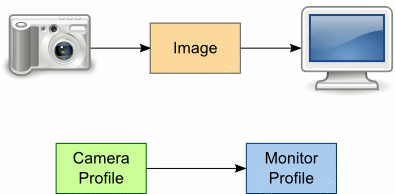Color Management Basics
Colors are device-dependent: the color you see depends on the device producing it. That is why the color you see at one stage of production rarely matches what you see at another stage. Computer monitors, digital cameras, scanners, and printers produce colors differently, but even in the same product line, two monitors produced by the same manufacturer can be slightly different. In fact, even the same device can produce different colors. For example, the colors of a printed image depend not only on the printer, but also on the paper, and inks, or toners used.
The other important consideration for a developer is a device's color gamut, which refers to its ability to capture or display a range of colors. Because there are several factors, including different ways of producing colors, varying device conditions, varying levels of quality, etc., every device has its own unique gamut. The result of all of this variance is that the same picture will be displayed differently on different devices. To make sure an image is displayed identically on different devices, you need to use color management.
Device Profiles
A system that implements color management must be able to obtain the color characteristics and color gamuts of different devices. The system gets this information from files (called device profiles) that are supplied by device manufacturers. A device profile characterizes the particular device by describing its color characteristics. Some devices, like monitors, have only one profile. Other devices such as printers may have several profiles as any change of paper, ink, etc. needs to be accounted for in a separate profile.
Profiles can also be embedded within image files. An embedded profile allows for the automatic interpretation of color information for a specific image. For more information see the Working with Embedded ICC Profiles topic.
How It Works
To convert a picture between two different color devices, you need two device profiles. It does not matter if the color format of the image should be changed or not. The first profile describes the color characteristics of the original image, and the second one corresponds to those of the destination device where the image will be displayed. The conversion diagram is as follows:

Examples of Using Color Management
Color management should be used each time you are converting an image with a color profile. Here you can see the most common use cases for color management:
- Making ready-to-preview images with standard sRGB profile converted from another profile, including CMYK, AdobeRGB, etc.
- Converting an image to CMYK profile for printing.
- SoftProofing - this is a mechanism that allows you to preview on your monitor what a printed image will look like.